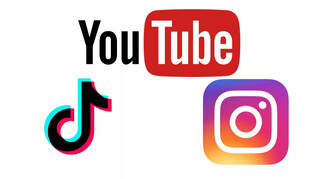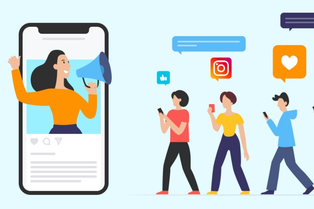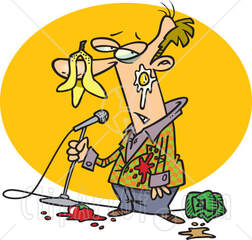 Up until now we haven’t posted much about using YouTube, Instagram and TikTok for book marketing. It isn’t because they aren’t any good for marketing. In fact, just the opposite. Those platforms are as good, if not better, than Facebook or X for selling your books. No, the reason we haven’t posted about them before is that you have to think about how you use them in a different way from other social media. Because of that we’ve been trying out different approaches of our own to see what works – and what doesn’t. Just posting an image of your book cover isn’t going to sell your book on those 3 channels. Not even making a book trailer featuring your book is going to work.  The reason why is that those 3 marketing channels work on the basis of personal interaction. What do we mean by that? After all, it is someone talking on a video. How can anyone interact with that? Well, they interact on a psychological level. The viewer sees the person in the video talking directly to them and to no one else. The video speaks to them personally. Now, there are a number of techniques that the people in the videos use and they vary according to what is being sold. I’ll illustrate what I mean with some examples.  Let’s start with the “influencers”. These people make a lot of money because they sell products on behalf of brands. But they never use the word “sell”, or “buy” or make any other reference to commercial transactions. I’ll use a stereotypical influencer to illustrate: the make-up demonstrator. They open with a line such as “I want to show you this great new lipstick (or whatever) I’ve just discovered.” Of course, their tone of voice is excited. This lipstick is so great they can’t contain their excitement about it. Which gets the viewer excited because excitement is contagious. Straight away the viewer is interested because the influencer is letting them in on their new discovery, not trying to sell them the lipstick (even though they are). They are sharing a secret with them. Those are very intimate acts, and we respond to them at an emotional level. They then demonstrate their use of the lipstick, which makes them look fabulous of course, and the viewers want to look just like the influencer, so they buy the product. The influencer may not even mention where the viewer can buy the product. They’ll show them the brand name, of course, but then they’ll leave it up to the viewer to follow-up because that way they won’t feel pressured into buying. The technique isn’t new. Product demonstrators have been around almost as long as products, but in the past they were standing in front of you rather than appearing in videos on-line.  Next we have the musicians. Their technique is different. They’ll start by saying something like “This is my latest song which I want to share with you.” Again, you are being drawn into an inner circle of intimacy. They then sing a verse and a chorus. If you like the song, you then have to either buy it to hear the rest or add it to a playlist. Either way, the musician sells their music without actually selling it.  Then we have the comedians. They post video clips of their act. They make you laugh, so when they announce their next gig or their next tour, you want to go along and see them, so you buy tickets. That is more of a delayed reaction, but it means more ticket sales than if they hadn’t posted the clip. So, three different techniques for three different types of product. There are other types, but those serve my purpose in illustrating how the channels are used in different ways.  Now, how do you adapt this to suit your product – a book? With YouTube you can adopt the same technique as a musician and read an extract from your book. You don’t have to show your face if you don’t want to but setting the scene is important; use the camera to act as the viewers' eyes, perhaps finding the book on the arm of a comfy chair and settling down to read it. The voiceover then reads the extract, which you can do yourself It will probably take you a few goes to get the sort of image you want, but it will work. Put an “end board” on the video saying where it can be bought and provide a link in the video’s description along with the blurb and some suitable hashtags. If you use Canva or BookBrush (or similar packages) you can make videos of someone reading an extract. For example, if your book is set at sea you can uses a video of a seascape with you reading the extract as the soundtrack. Then promote the heck out of the video on your other social media.  Instagram and TikTok aren’t so well suited for readings. Their users have short attention spans. Anything longer than a minute probably isn’t going to be watched to the end. And anything that isn’t eye catching isn’t going to be watched at all. The first 5 seconds of the video is crucial to grabbing the viewer’s attention. This is where you have to project your personality as an author. If you try to pitch your book, you won’t sell anything. You have to pitch the idea of books in general and then mention your own books in passing. A popular style in recent months has been “Five books I wish I could discover all over again”. You don’t have to show your face, you just have to show the book covers and maybe your hands flicking through the pages. And, of course, you have to talk about why the books mean so much to you. Then you segue into how those books inspired you to write your own book, a copy of which you also happen to have in camera shot. You can talk about your own books, but you have to put a new twist on it.  People love stories. People love stories. People, especially those that read books, love stories, so use that to your advantage. One of our authors laid out his books on a table then said that not only did the books tell a story, they each had a story of their own, which was how they came to be written. He then made a separate video for each one and told the story of how he had been inspired to write it, into which he wound some of the book’s plot and characters. And it worked. Each video sold copies of the book he was talking about. But he never actually talked about the book in the way he would have in a written blurb. I would recommend going onto TikTok and Instagram and using the hashtags #Booktok and #bookstagram to see what other authors are doing on there. If your favourite authors have TikTok or Instagram accounts, see what sorts of content they post to promote their work. Remember, imitation is the sincerest form of flattery. Identify the sorts of videos that make you feel good about the author and their products, not the ones that are trying to pitch books directly to you. Emulate the former, not the latter.  Unlike X or Facebook, these channels aren’t about how many followers you have. Your videos will be shown to users based on what they like to see, so it doesn’t matter if they follow you or not. If they are using any of the hashtags that relate to books or reading, there’s a good chance your video will be shown to them if you have used related hashtags, including genre hashtags Of course, if they follow you that’s a bonus, because it means they will definitely see your videos in the future. But that isn’t as important as it would be on X or Facebook. Once again we must add a “health warning” that using YouTube, Instagram and TikTok isn’t going to turn you into a best selling author overnight. But they can add additional strings to your marketing bow. Experiment and have fun. You have nothing to lose except for a bit of time.  Just a few tips for you. Make sure that any book titles haven’t become reversed during the recording process. I recently watched some TikTok videos by an author I follow and in a couple of them her book titles appeared as “mirror images”. This is a common problem when using the camera in “selfie” mode and holding the book up in front of your face (try it if you don’t believe me). If you have friends who read your books, ask them to do video reviews for you on TikTok or Instagram, making sure they use suitable hashtags, including your author name. Vary your styles and themes. If all the videos you post look the same or sound the same, people will lose interest.  Be patient (yes, that old one again). If you are just starting out on these channels it will take time for people to find you and to share your videos. But they will if you give them long enough. Post as frequently as possible. Yes, it’s a big time commitment to keep on making new videos, but anything worth doing is worth investing the time into doing it. Use "dead time" to make videos, eg when commuting, coffee breaks, lunchtime etc. For those of you who have never used these platforms, here are some links to helpful videos on how to use TikTok. Most of what they say can be applied to YouTube and Instagram too. TikTok Beginner’s Guide https://www.youtube.com/watch?v=rjjjlJw2cgM How to make TikTok Videos https://www.youtube.com/watch?v=vAho-cr5UxY 10 Mistake TikTok users make https://www.youtube.com/watch?v=nrY9HpJd6zE Hashtags https://www.youtube.com/watch?v=xcZHGr_xpII If you have enjoyed this blog, or found it informative, then make sure you don’t miss future editions. Just click on the button below to sign up for our newsletter. We’ll even send you a free ebook for doing so.
0 Comments
Leave a Reply. |
AuthorThis blog is compiled and curated by the Selfishgenie publishing team. Archives
June 2025
|
 RSS Feed
RSS Feed